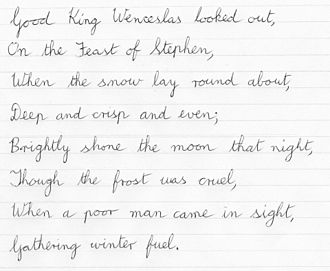Up until recently, in all English-speaking countries children learned printed and cursive letters. Reading and writing flawlessly cursive texts was a sign of penmanship. Today it is being replaced by typing. Our kids do not understand the journals written by our parents. Is it such a big deal? What are we actually losing?
Who stopped teaching cursive writing?
That’s actually strange. It’s not like there was one global decision by some council to stop teaching cursive. In the USA it is not a state decision. Simply schools one by one stop penmanship programs and teach blind typing instead.
The reason is very simple. We do not have to write fast, or as much as we used to. If anything, we need to type fast. And we occasionally write small post-it notes. But that does not justify elaborate penmanship programs.
Is that just an American thing?
Cursives and languages
Strangely the three languages I consider my mother tongue also represent three kinds of cursive. We will get to English cursive shortly.
In Cyrillic many or all letters in a word are connected making a word one single complex stroke. There are no crosses in “t” or dots in “i”. The letters that are different are quite rare. Russian cursive has quite a reputation of being difficult to read. Even for me, and this is my first language. Quite often when in a hurry, “m” or “nn” look alike. Add to this Russian equivalent of “sh” and “i” that look like flipped “m” and “n”… In Russian these combinations are common. At the same time, Russian cursive writing is FAST, which is a huge advantage. Cursive reading can be slow, especially if the text is written by a doctor.
In Hebrew cursive (and in old Roman cursive) the letters are not connected. They are very different from printed letters and easy to write with very simple strokes. The letters are also surprisingly easy to read fast as they do not connect. However, the pen jumps up and down quite a lot. Probably ancient Hebrew scribes used a stylus, which is less flexible and not as fragile as a quill.
The origins of cursive
The first people to write in ink with a reed pen (basically a stylys) on papyrus were the Egyptians. In the public spaces of ancient Egypt, we see beautiful hieroglyphs. However, this script is damn hard to use: it was mostly reserved for formal situations. So Egyptian priests of the third millennium BC invented a very special script called hieratic, and it might have been the first cursive script. It was also the writing system first taught to students, knowledge of hieroglyphs being limited to a small minority who were given additional training.
Romans also used cursive scripts. The original Roman cursive looked a bit strange. Around the 3rd century AD new cursive script was developed from old cursive, and this script looks very much like the cursive we use today. “a”, “b”, “d”, and “e” have taken a more familiar shape, and the other letters are proportionate to each other rather than varying wildly in size and placement on the line.
Styles varied widely by region, however, so in the late eighth century Charlemagne tasked an English monk with standardizing the craft. Influenced by Roman characters, Carolingian minuscule was designed for maximum legibility and featured lowercase letters, word separation, and punctuation.
Three kinds of English cursive
Ligature is writing the letters of words with lines connecting the letters so that one does not have to pick up the pen or pencil between letters. Ancient (not metal) quills used to be very fragile, and if one does not have to pick up the quill between letters, writing gets easier on the writer and on the quill. If the connecting likes are straight, reading the cursive is pretty fast.
In looped cursive penmanship, some ascenders and descenders have loops that provide for joins. This is the way we call “proper” cursive today. The loops make reading and writing easier, but they also generate the main difference between the printed and the scripted letters.

There is also a more formal version, called cursive italic, using no loops and no joints and slanted letters. Italic penmanship became popular in the 15th-century Italian Renaissance. While beautiful and easy to read, this sort of script is slower to write in. By the 1550s the Italic script had become so laborious that it fell out of use with scribes.
The “proper” looped cursive
Founded by Master Penman Charles Paxton Zaner, the company’s history can be traced back to 1888 when it was known as the Zanerian College of Penmanship.
Zaner-Bloser is the “proper” modern looped handwriting approach for personal and business communication. The focus in this particular penmanship school was less on beautiful calligraphy, and more on productivity and eclectic learning.
A penman is a vintage title that was given to someone whose career and professional skill sets were in the area of penmanship of various types. Art colleges were set up around the country to train men and women in the many disciplines of penmanship and hand-drawn letterforms. Before the typewriter, this was a booming career path, as nearly every major business needed a competent and proficient penman on hand to manage log books, keep records, write policies, and execute certificates.
The looped Zaner-Bloser writing was easy to read, yet it was faster to write and it was ornamental. So it became the ruling advanced handwriting system in many schools.
Hybrid script
People who do not learn looped cursive in schools, often use a hybrid script which I would call neo-italic. In a similar way, the printed scripts we use today like Helvetica are classified as neo-gothic.
What does today’s cursive look like? Some letters are slanted, but some might be oblique. The letters are disjointed, as we write with ballpoint pens and pencils. Moreover, some letters like “r” and “s” can appear both in printed and in cursive form. In my eyes, they appear as a minimalistic version of cursive italic. Loops are optional and often omitted.
Getty-Dubay is a modern version of an Italic script developed as a teaching script in 1976 by Barbara Getty and Inga Dubay that is supposed to ease the transition to cursive. Other than strokes to join the letters, only the lower-case letter ‘k’ and a few upper-case letters have forms different from their printed equivalents.
D’Nealian, sometimes misspelled Denealian, is a style of writing and teaching cursive and manuscript handwriting. It was developed by Donald Thurber while teaching in a primary school and was first introduced in 1978. D’Nealian is taught extremely early, to first and second grade students, many of whom are still learning the rudiments of print-style writing
The hybrid styles are easier to learn and read. The letters often look like Ronde – a French variation of Gothic cursive used by the French Ministry of Finance until right after World War II. In Ronde, the strokes are heavy and nearly upright, friendly to flexible metal nibs.
The nib
When using a ballpoint pen, we are not very sensitive to the kind of script we use. The ballpoint pen can write from any angle indiscriminately. The proper handwriting in private schools where money is not a limitation is taught with a fountain pen.
The fountain pens can use more vibrant water-based inks. Gold nib pens look exclusive and feel special. Executives use fountain pens to sign the most important documents. For example, the US presidents historically use Cross fountain pens. Since the main thing we write in cursive is our signature, learning to write it properly with a proper pen is an important skill for the creme de la creme.
Fountain pen nibs, especially the flexible golden nibs, are kind of sensitive to the pressure applied. In fact, Pelikan, Lamy, and Faber Castell have a nib size called ‘A’ that is specifically made for a beginner (or an architect or Hebrew writer). Other nibs are used to make thick vertical lines and thin horizontal lines and joints, by changing the pressure on the nib. The result is beautiful and impressive, but probably not as fast as using a mechanical pencil.
It takes time, effort, quality pens, and good paper to generate proper penmanship with a fountain pen. Master penmen may use pens with wide italic nibs for titles, medium round nib pens for the text, and needle-like extra-fine nib pens for footnotes and annotations. Generating consistent fonts with different pens and nibs is a part of the calligraphy training. Anyone can learn that, but learning takes time.
So, what did we actually lose?
To be honest we did not lose that much… Private schools can still teach the Zaner-Bloser method with fountain pens, but the rest can learn some hybrid script with a ballpoint pen, at least until the second grade when typing becomes more useful than hand-written notes.
The hybrid scripts are somewhat erratic and hard on the nib, but they work quite well with ballpoint pens. With some practice, the writing speed is comparable with proper cursive. Moreover, the legibility does not decrease as sharply with speed, as it happens with the Zaner-Bloser method.
A person who knows proper looped cursive can easily read any hybrid script, but not vice-versa. So what? How often do we get a chance to look into our grandmother’s diary?
I learned to write looped cursive in Russian. When I was 14 years old, I accidentally found my mother’s teenage journal. It was the most boring reading material in my memory, full of no-longer-relevant cultural references and meaningless gossip about people my mother’s age.
Recently I found my own diaries from the period when I was 14 years old. It was filled with songs and words of wisdom I wrote. I remember, when writing it I felt that I was creating something valuable. Believe me, upon rereading I seriously doubted the cultural value of the text.
Anna Frank was unique. Most teenagers write very very boring diaries. They are not really worth rereading.

